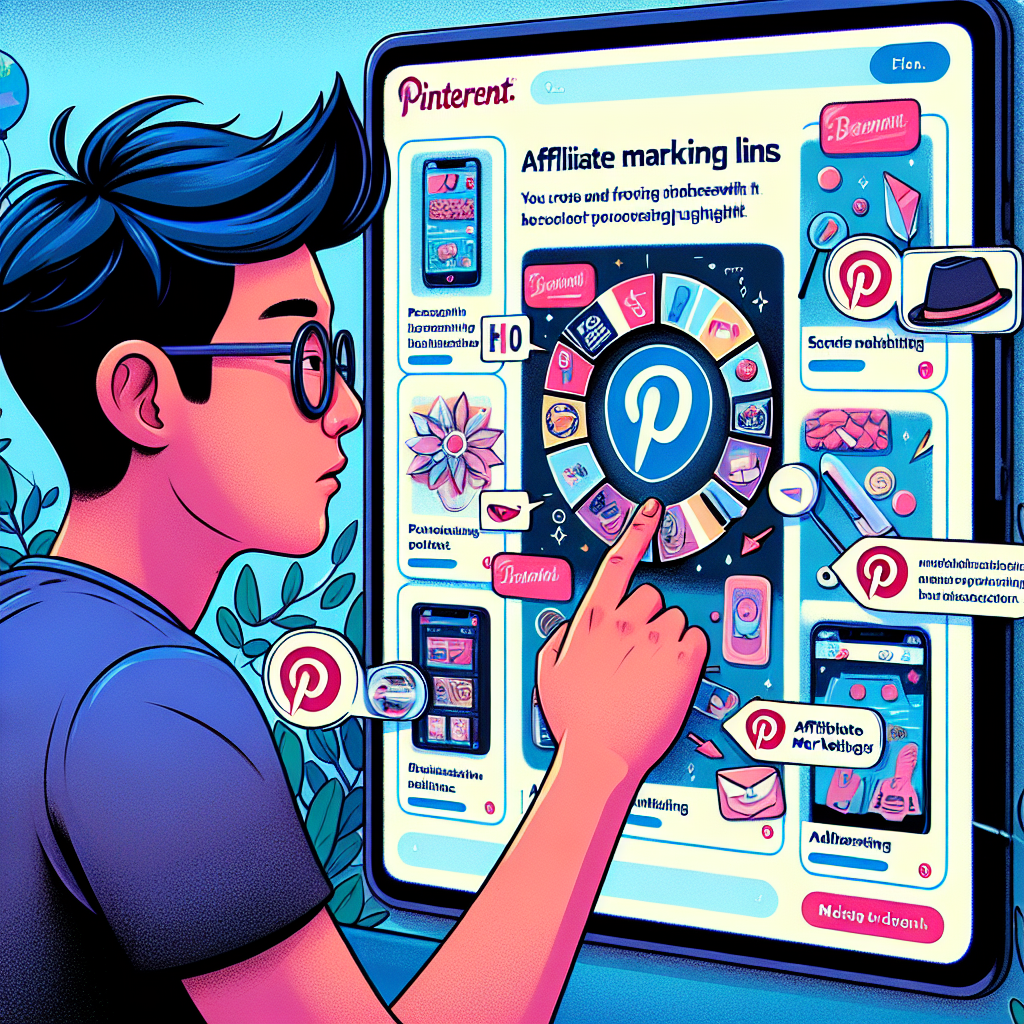Are you a marketer looking to utilize Pinterest for affiliate marketing? If so, you’re in the right place! In this article, we will explore the best practices for affiliate marketing on Pinterest. From creating eye-catching pins to optimizing your boards, we will provide you with valuable tips and strategies to help you succeed in this fast-growing platform. So, get ready to boost your affiliate marketing efforts on Pinterest with these proven techniques.

Choosing the Right Affiliate Programs
When it comes to affiliate marketing on Pinterest, one of the first and most important steps is choosing the right affiliate programs to join. Researching and selecting reputable affiliate programs is crucial to ensure that you are partnering with trustworthy brands that align with your values and provide high-quality products or services.
Start by researching different affiliate programs in your niche or industry. Look for programs that have a good reputation, positive reviews from affiliates, and a track record of paying out commissions on time. It’s also important to consider the commission rates and payment structure of affiliate programs. Some programs may offer higher commission rates, but have a more complex payment structure, while others may have lower commission rates but provide more consistent payouts.
Take your time to thoroughly research and compare different affiliate programs. Consider factors such as the quality of the products or services, the brand’s reputation, and the potential earning potential. By choosing reputable affiliate programs that align with your audience’s interests, you can increase your chances of success in affiliate marketing on Pinterest.
Optimizing Your Pinterest Profile
Creating an optimized Pinterest profile is essential for attracting and engaging your audience. Start by creating a business account on Pinterest. This will give you access to valuable analytics and other features that are not available with personal accounts.
Next, use relevant keywords in your profile description. Think about the niche or industry you are targeting and include keywords that your audience is likely to search for. This will help Pinterest understand what your account is about and make it easier for users to discover your profile and pins.
In addition to including keywords, make sure to add a link to your website or blog in your profile. This will drive traffic to your website and increase the chances of earning affiliate commissions. Choose a clear and professional profile picture that represents you or your brand. This will help build trust with your audience and make your profile more visually appealing.
Finally, organize your boards into relevant categories. This will make it easier for users to find specific content and navigate through your profile. By optimizing your Pinterest profile, you can attract more followers and increase the visibility of your pins, ultimately driving more traffic and potential affiliate sales.

Creating Engaging Content
To be successful in affiliate marketing on Pinterest, it’s important to create engaging content that resonates with your audience. Start by understanding your Pinterest audience’s interests and preferences. Analyze your analytics to determine what types of content perform well and what topics your audience engages with the most. This will help you tailor your content to meet their needs and interests.
When creating pins, focus on creating visually appealing and high-quality images or graphics. Pinterest is a highly visual platform, so it’s important to capture attention with eye-catching visuals. Use clear and vibrant images that align with your content and use graphics or overlays to highlight key points or benefits.
In addition to visually appealing pins, make sure to use compelling and informative pin descriptions. Use keywords strategically in your descriptions to improve searchability and provide valuable information to your audience. Consider using relevant hashtags to increase the discoverability of your pins.
Experiment with different pin formats, such as product pins or story pins, to see what resonates with your audience. Different formats may perform better for different niches or industries, so it’s important to test and adapt your pinning strategy accordingly.
Building a Targeted Audience
Building a targeted audience is essential for the success of your affiliate marketing efforts on Pinterest. Start by engaging with other pinners by liking and commenting on their pins. This will help you build relationships and gain visibility within the Pinterest community. Make sure to follow relevant Pinterest accounts and boards to stay updated on the latest trends and industry news.
Participating in group boards and collaborations is another effective way to expand your reach and connect with a larger audience. Look for group boards in your niche and request to join or collaborate with other pinners in your industry to create collaborative boards.
Promoting your Pinterest profile on other social media platforms or your website/blog is also crucial for building a targeted audience. Share your Pinterest profile link on your Facebook page, Instagram bio, or include it in your blog posts. This will drive traffic to your Pinterest profile and increase your chances of gaining followers and potential customers.
Utilize Pinterest analytics to understand and target your audience better. Keep track of your audience’s demographics, interests, and engagement metrics. This data will help you tailor your content and marketing efforts to better meet the needs of your audience.

Optimizing Your Pin Descriptions
Optimizing your pin descriptions is essential for improving the discoverability and click-through rate of your pins. Start by including relevant keywords in your pin descriptions. Think about the words or phrases your audience is likely to search for and incorporate them naturally into your descriptions.
When writing pin descriptions, aim to be clear and concise. Use language that encourages action and elicits curiosity. For example, instead of simply describing a product, highlight the benefits or unique features that make it worth clicking on.
Using CTAs (Call to Action) is another effective technique to drive traffic to your affiliate links. Include phrases such as “click here for more information” or “shop now” to encourage users to take action. Remember to avoid excessive self-promotion and focus on providing value to your audience.
Creating Compelling Pin Images
Creating compelling pin images is crucial for attracting attention and encouraging users to click through to your affiliate links. Start by using high-quality images or graphics that capture attention. Invest in professional photos or use high-resolution stock images that are relevant to your content.
Adding text overlays to your pin images can help highlight key points or benefits and make them more compelling. Use clear and easy-to-read fonts and choose colors that complement your image. Keep in mind that Pinterest’s guidelines recommend using less than 20% text in an image.
Optimizing pin dimensions is also important for better visibility. Pinterest prefers a vertical 2:3 ratio, with a recommended size of 1000 x 1500 pixels. This size makes your pins stand out and ensures they are displayed properly across different devices.
Using branded elements or logos in your pin images can increase brand recognition and enhance your credibility. Include your brand’s colors, fonts, or logo in the pin design to create a consistent visual identity across your pins.
Testing different pin designs and formats is essential to understand what resonates with your audience. Experiment with different colors, layouts, and styles to see what generates more clicks and engagement. Analyze the performance of your pins and make adjustments accordingly.

Strategically Placing Affiliate Links
Strategically placing affiliate links is key to driving traffic and increasing the chances of earning affiliate commissions. Start by including affiliate links in relevant pin descriptions. When creating pins, make sure to provide a clear and visible call-to-action that prompts users to click on the pin and visit your affiliate link.
Many affiliate programs provide native affiliate linking tools that make it easy to create trackable links. Take advantage of these tools to ensure your affiliate links are properly tracked and credited.
Strategically placing affiliate links within your blog posts or website content is another effective way to drive traffic to your affiliate partners. Write informative content that naturally incorporates affiliate links, providing genuine value to your audience. Avoid excessive use of affiliate links that can be perceived as spam and may result in lower engagement or a negative user experience.
It’s important to disclose affiliate links according to FTC guidelines. Be transparent with your audience and clearly indicate when a link is an affiliate link. This builds trust with your audience and ensures compliance with legal requirements.
Utilizing Pinterest SEO Techniques
Utilizing Pinterest SEO techniques can improve the visibility and searchability of your pins. Start by researching and using relevant keywords in your pin titles and descriptions. Think about the words or phrases your target audience is likely to search for and incorporate them naturally into your content.
Optimize your pin and board names with targeted keywords. This will help Pinterest understand the content of your pins and boards and improve their visibility in search results. Use descriptive names that accurately represent the content and topic of your pins.
Including relevant keywords in your board descriptions and category selection is also important for optimizing your content for search. Think about the keywords your audience is likely to use when searching for content in your niche and incorporate them into your board descriptions.
Use the Pinterest search bar to find popular and trending keywords. This will give you insights into what topics are currently popular and help you tailor your content to meet the needs and interests of your audience.
Monitor and analyze the performance of your keywords using Pinterest analytics. Keep track of which keywords drive the most engagement and traffic to your pins. This data will help you refine your keyword strategy and optimize your content for better results.
Driving Traffic to Your Pins
Driving traffic to your pins is crucial for increasing visibility and maximizing your chances of earning affiliate commissions. There are several strategies you can use to promote your pins and expand your reach.
Start by promoting your pins on other social media platforms. Share your pins on Facebook, Twitter, Instagram, or any other platforms where your audience hangs out. Use compelling captions and include a call-to-action that encourages users to click on the pin and visit your affiliate link.
Embedding pins in your blog posts or website is another effective way to drive traffic to your pins. Choose relevant pins that complement your content and add value to your audience. This will encourage users to click on the pin and explore more of your content on Pinterest.
Including Pinterest sharing buttons on your blog or website makes it easy for visitors to share your content on Pinterest. This can help increase the visibility and reach of your pins, as well as drive more traffic to your Pinterest profile.
Collaborating with influencers or popular pinners in your niche is a great way to expand your reach and attract a larger audience. Partner with influencers or popular pinners to create collaborative boards or cross-promote each other’s content. This can expose your pins to a wider audience and increase the chances of earning affiliate commissions.
Using Pinterest ads, also known as Promoted Pins, is an effective paid advertising option to increase the visibility and engagement of your pins. Promoted Pins can help you reach a larger audience and drive targeted traffic to your affiliate links. Set a budget and target specific demographics, interests, or keywords to maximize the effectiveness of your Pinterest ads.
Analyzing and Optimizing Your Performance
Analyzing and optimizing your performance is essential for continuous improvement and maximizing your affiliate marketing efforts on Pinterest. Regularly review Pinterest analytics to track the performance of your pins. Pay attention to key metrics such as impressions, engagements, click-through rate, and conversions.
Identify the most successful pins and analyze what factors contribute to their success. Is it the visual design, the pin description, or the topic? Use this information to optimize your future pins and make adjustments to improve their performance.
Tracking the click-through rate and conversion rate of your affiliate links is crucial for evaluating the effectiveness of your marketing efforts. If certain pins or affiliate links are not performing well, experiment with different strategies or make adjustments to improve the results.
Experiment with different pin strategies and measure their impact. Test different visuals, pin designs, descriptions, and posting schedules to see what resonates with your audience. Keep an eye on the latest trends and changes in Pinterest’s algorithm to stay ahead of the game.
Remember, affiliate marketing on Pinterest requires continuous learning, adaptation, and optimization. Stay proactive in analyzing your performance, experimenting with new strategies, and keeping up-to-date with the latest trends to maximize your success.
